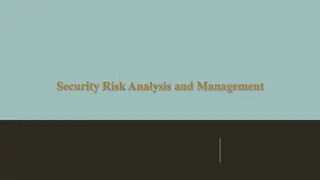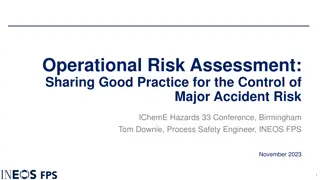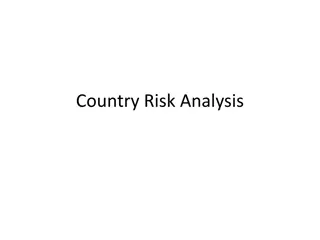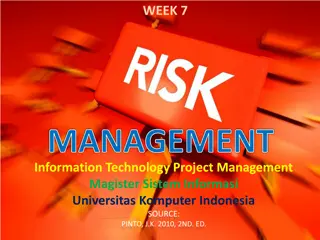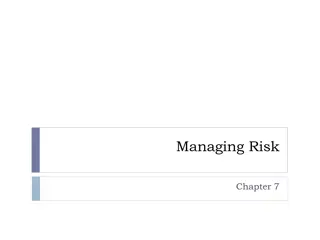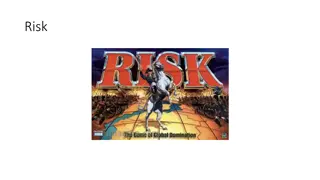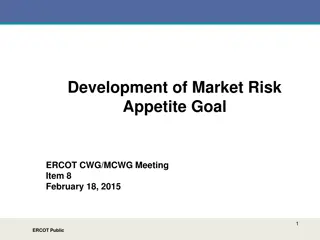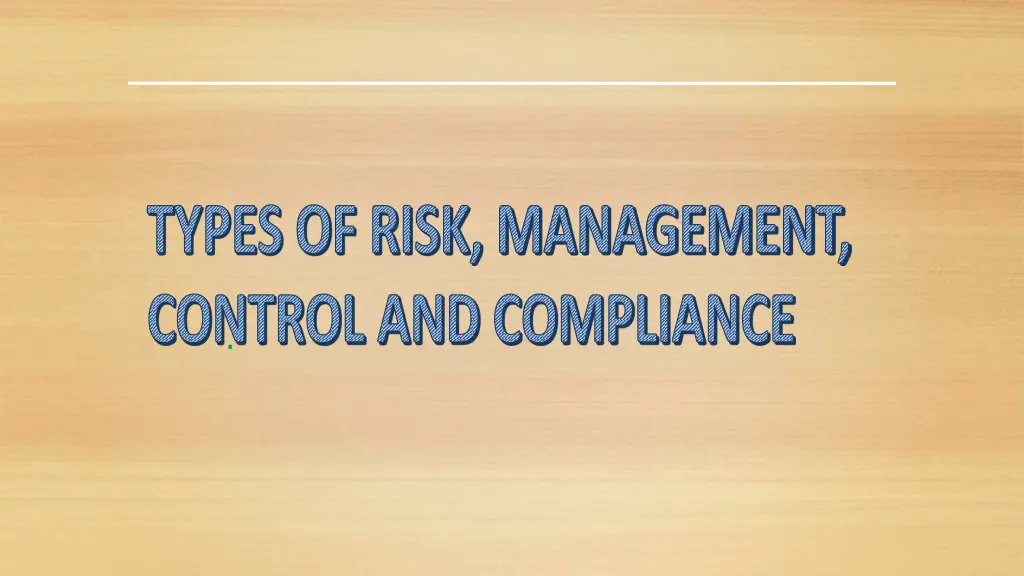
Managing Risk in Banking and Trading
Explore the various types of risks in risk management, control, and compliance in the banking and trading sectors, including interest rate risk, currency risk, credit risk, liquidity risk, and more. Learn how these risks impact earnings and capital, and the strategies used to mitigate them.
Download Presentation

Please find below an Image/Link to download the presentation.
The content on the website is provided AS IS for your information and personal use only. It may not be sold, licensed, or shared on other websites without obtaining consent from the author. If you encounter any issues during the download, it is possible that the publisher has removed the file from their server.
You are allowed to download the files provided on this website for personal or commercial use, subject to the condition that they are used lawfully. All files are the property of their respective owners.
The content on the website is provided AS IS for your information and personal use only. It may not be sold, licensed, or shared on other websites without obtaining consent from the author.
E N D
Presentation Transcript
TYPES OF RISK, MANAGEMENT, CONTROL AND COMPLIANCE .
Risk Management & Types of Risks FMDA 1. Interest Rate Risk 2. Currency Risk 3. Liquidity Risk 4. Credit Risk 5. Sovereign Risk 6. Settlement Risk 7. Operational Risk 8. Legal Risk 9. Counterparty Risk
FMDA Interest Rate Risk 1.This is the probability that the changes in the interest rates will adversely affect earnings of a bank. Interest rate exposure constitute a serious threat to a bank s earnings. 2.The issues to focus in this regard are: Trend frequent changes in interest rates. Forecasting and modelling effective planning. Gap analysis rate management tool. see the next 3 slides
SOURCES OF RISKS IN TRADING & BANKING BOOK FMDA Sources of Financial Risks in Trading & Banking Book. Equity Risk Commodity Risk Interest Rate Movement Credit Risk Exchange Rate Liquidity Risk Interest Rate Risk in the Banking book is handled under Asset Liability Management. * Liquidity risk across Trading & Banking book are covered under Asset Liability Management
INTEREST RATE RISK IN THE BANKING BOOK FMDA Interest Rate Risk is defined as the current or prospective risk to both the Earnings and Capital of the Bank arising out of adverse movements in interest rates. Interest Rate Risk Yield Curve Risk Basis Risk Repricing Risk Options Risk
Gap versus duration matching FMDA 1. Gap analysis is normally to manage interest rate volatility. It is a tool for a balance sheet risks analysis. 2. A gap exists in a bank s balance sheet when the maturities of its assets and liabilities are not perfectly matched - this is what obtains in reality. 3. A treasurer can open or close a gap to make more money, reduce cost or shield the bank against liquidity risks 4. Duration matching however is a process whereby asset are matched with liability on the basis of tenor. Duration matching is easily done with funds from specific sources and such funds should be large to actually yield good return.
Step 1 Segment The Balance Sheet FMDA Rate Sensitive Assets Overdraft Call Placements OBB (Open Buy Back) Floating Rate Debenture Rate Sensitive Liabilities Call Deposits Floating Rates Deposits Special Products with flexible rates Fixed Rate Assets Term Loans Treasury Bills Fixed Placements Leases Fixed Rate Liabilities Savings Demand Deposits Term Deposits Fixed Deposits Non Earning Assets Cash in vault, premises and transit Fixed Assets Other Assets Non Earning Liabilities Other liabilities subj. to negotiation Accruals Unpaid dividends and tax Capital + Reserves 7
Step 2 Take Positions FMDA 1. 2. Establish or Forecast the direction of the interest rates. Form expectations on magnitude of interest rate changes and prepare scenarios. Open a positive gap when rates are expected to rise. Open a negative gap when rates are expected to fall. Close the gaps to take advantage if the earlier expectation changes from earlier forecast. Extend a gap if opportunities exist to make more profit. 3. 4. 5. 6. 8
Earnings At Risk (EAR) FMDA 1. EAR is the sensitivity of the accrual portfolio to a change in the interest rates in the adverse direction over a period of improper performance approved by Management. 2. Below are the steps normally used to calculate EAR: a.Establish the gap for each currency based on assets and liabilities. b.Establish the change in interest rates as a result of re-pricings carried out. c.Multiply the established gap with the difference in interest rates at each point and add the differences to establish the earnings at risk. 9
Currency Risk FMDA 1. 2. These are also called Foreign exchange risks They result from changes in exchange rates 3. They originate from mismatches between the values of assets and liabilities denominated in different currencies Counter party risk Settlement risk Liquidity risk Currency related interest rate risk 4. 5. 6. 7. 10
Currency Risk Management FMDA 1. Issues that may come up in the day-to-day foreign exchange transactions that require management are. Unexpected corrections in currency exchange rates Wild variations in foreign exchange rates Volatile markets offering profit opportunities Lost payments Delayed confirmation of payments and receivables Divergence between bank drafts received and the contract price 2. Currency risks are managed by establishing position limits, hedging process and Skills. MMAN 11
Liquidity Risk FMDA An institution faces two kinds of liquidity risk: Market liquidity risk is related to the ease at which products and instruments can be sold or the risk unwound in the markets. Funding liquidity risk is related to the ability of the institution to obtain funds to finance its activities MMAN 12
Liquidity Risk Management FMDA Liquidity management is a key banking function and an integral part of the Asset and Liability Management process. Most banking activity depends on a bank s ability to provide liquidity to its customers Most financial transactions or commitments have implications for a bank s liquidity 13
Liquidity Risk Management Contd FMDA The source of deposits ( who supplies the funding) adds to the volatility of funds, as some creditors are more sensitive to market and credit events than others. Diversification of funding sources and maturities enables a bank to avoid the vulnerability associated with the concentration of funding from a single source. 14
The Need For Liquidity FMDA Liquidity is necessary for banks to compensate for expected and unexpected balance sheet fluctuations and to provide funds for growth. It represents a bank s ability to efficiently accommodate the redemption of deposits and other liabilities and to cover for funding increases in loan and investment portfolio 15
Adequate Liquidity Potential FMDA A bank has adequate liquidity potential when it can obtain needed funds by: Increasing liabilities Securitizing Selling illiquid assets promptly and; At a reasonable cost 16
Liquidity Risk Management FMDA It focuses on the management of expected cash flows. Liquidity risks are normally managed by banks Asset and Liability Management Committee (ALCO). ALCO must therefore have a thorough understanding of the interrelationships between liquidity as well as other market and credit risk exposures on the balance sheet. 17
Credit Risk FMDA Credit risk is the risk that a counterparty will not perform on an obligation owed to the institution. Arises from a counterparty s inability to pay an obligation when due, including the failure of clearing and settlement activities. Credit risk also includes the risk that related collateral may not be adequate. Credit risk assessment varies with different types of clients Agents, sub- custodians, issuers/ borrowers, counterparties, sovereign risk, country risk. Accordingly different risk reduction measures are employed: Indemnifications, risk reduction, enhancements, and collateral. 18
Sovereign Risk FMDA Sovereign Risk also known as Country Risk is the risk of default in meeting the debt obligation by a Country. It is the broadest measure of credit risk and includes country risk, political risk, and transfer risk. One of the biggest unfortunate aspects of Sovereign risk is that it is contagious in nature which means that what affects one country tends to affect other countries as well due to the globalized interconnected world. It is here to stay due to the inherent linkage between global economies. 19
How Sovereign Risk is measured FMDA There is no formula to calculate Sovereign Risk. Instead, it is measured by Sovereign Risk Rating which measures the Default risk and is usually assigned by Global rating agencies such as Moody s, Standard and Poor (S&P), Fitch, etc. Such Sovereign ratings assess the Risk by analyzing the ability and willingness of a country to service its debt which includes evaluation of relevant solvency and liquidity factors of the country, the political stability of the country in question as well as any limiting factors such as Financial Network and Social unrest in the country. 20
Settlement Risk FMDA Settlement risk is the risk that an institution will not receive funds or instruments from its counterparties by the expected time.. This is the risk that we have settled the full value of the contract and do not receive the counter value. This type of risk usually results from the time lag between the sending of a payment instruction for the sold currency in a foreign exchange deal and the confirmation of receipt, with finality , of the purchased currency. Two elements are involved : The amount purchased The size of the time lag. 21
Operational Risk FMDA Operational risk refers to the risk that deficiencies in internal systems or controls would lead to an unexpected loss. Operational risk could stem from a broad range of sources. These include deficiencies in the information system, inadequate procedures in the capture and settlement of trades, or failure to minimise human error. One important aspect of operational risk is rogue behaviour . This results from persons deliberately breaching procedures, and the failure of controls to prevent or detect such behaviour early. Operational risk is CONTROLLABLE within the organisation. This risk relates to failure to action or record transactions and/or the inability to provide meaningful management information to permit proper monitoring of business activities. 22
Legal Risk FMDA Legal risk can surface in two ways. The first is related to whether transactions are documented properly and are legally enforceable. The second aspect of legal risk is whether the institution discharged its legal and regulatory responsibilities to customers appropriately. 23
Counterparty Risk FMDA This is the risk that the customer with whom we have a reciprocal agreement (the counterparty ) defaults. This risk takes two forms: Settlement Risk Pre-settlement Risk. Apply to both spot and forward contracts Banks manage these risks by limiting counterparty exposure through FX Limits for banks and customers This can be divided into: Settlement Lines Pre-Settlement Lines 24
Objective of Risk Management FMDA Organizations face a wide range of uncertain internal and external factors that may affect achievement of their objectives whether they are strategic, operational, or financial. The effect of this uncertainty on their objectives can be a positive risk (opportunities) or a negative risk (threats). Risk management while internal control helps counter threats and take advantage of opportunities. focuses on identifying threats and opportunities, Proper risk management and internal control assist organizations in making informed decisions about the level of risk that they want to take and implementing the necessary controls to effectively pursue their objectives. 25
Objective of Risk Management FMDA Risk management and internal control are therefore important aspects of an organization s governance, management, and operations. Successful organizations integrate effective governance structures and processes with performance-focused risk management and internal control at every level of an organization and across all operations. However, risk management and internal control are not objectives in themselves. They should always be considered when setting and achieving organizational objectives and creating, enhancing, and protecting stakeholder value 26
RISK MANAGEMENT, MEASUREMENT & CONTROL FMDA Risk Controls Interest Rate Risk Minimize Funding Gaps Currency Risk Adhere to Net Open Position & Trader Limit Liquidity Risk Adhere to minimum Liquidity Ratio Counterparty Risk Risk- Assessment criteria Credit Risk Placement Limits, Dealing Limits, Risk Lines Legal Risk Seek Legal Advice 27
Disaster recovery and business continuity plan Business continuity plan: Is the way an organization can prepare for and aid in disaster recovery. It is an arrangement agreed upon in advance by management and key personnel of the steps that will be taken to help the organization recover should any type of disaster occur. These programs prepare for multiple problems. FMDA A Business Continuity Plan or BCP is how an organization guards against future disasters that could endanger its long-term health or the accomplishment of its primary mission. BCPs take into account disasters that can occur on multiple geographic levels-local, regional, and national-disasters like fires, earthquakes, or pandemic illness. BCPs should be live and evolving strategies that are adjusted for any potential disasters that would require recovery; it should include everything from technological viruses to terrorist attacks. 28
Disaster recovery and business continuity plan Disaster recovery : is the process an organization uses to recover access to their software, data, and/or hardware that are needed to resume the performance of normal, critical business functions after the event of either a natural disaster or a disaster caused by humans. While Disaster Recovery plans, or DRPs, often focus on bridging the gap where data, software, or hardware have been damaged or lost, one cannot forget the vital element of manpower that composes much of any organization. FMDA Disaster Recovery Plans are generally part of a larger, more extensive practice known as Business Continuity Planning. DR plans should be well practiced so that the key players are familiar with the specific actions they will need to take should a disaster occurs. 29
Know Your Customer FMDA Know your customer (KYC) is the process of a business verifying the identity of its clients. The term is also used to refer to the bank regulation which governs these activities. The objective of KYC guidelines is to prevent banks from being used, intentionally or unintentionally, by criminal elements for money laundering activities. Related procedures also enable banks to better understand their customers and their financial dealings. This helps them manage their risks prudently. Banks usually frame their KYC policies incorporating the following four key elements: Customer Policy; Customer Identification Procedures; Monitoring of Transactions; and Risk management. 30
Know Your Customer FMDA For the purposes of a KYC policy, a Customer/user may be defined as: a person or entity that maintains an account and/or has a business relationship with the bank; one on whose behalf the account is maintained (i.e. the beneficial owner); beneficiaries of transactions conducted by professional intermediaries such as stockbrokers, Chartered Accountants, or solicitors, as permitted under the law; or any person or entity connected with a financial transaction which can pose significant reputational or other risks to the bank, for example, a wire transfer or issue of a high-value demand draft as a single transaction 31
Know Your Customer FMDA KYC controls typically include the following: Collection and analysis of basic identity information (referred to in US regulations and practice as a "Customer Identification Program" or CIP) Name matching against lists of known parties (such as "politically exposed person" or PEP) Determination of the customer's risk in terms of propensity to commit money laundering, terrorist finance, or identity theft Creation of an expectation of a customer's transactional behaviour. Monitoring of a customer's transactions against expected behaviour and recorded profile as well as that of the customer's peers 32
REVIEW & DISCUSSIONS Review Review And And Discussions Discussions


